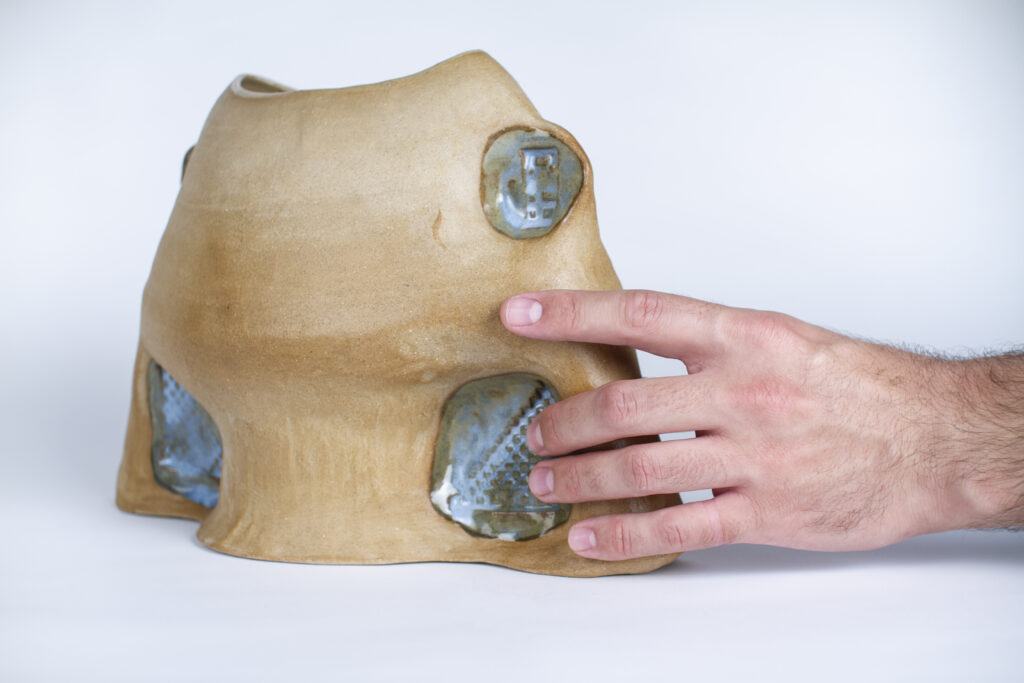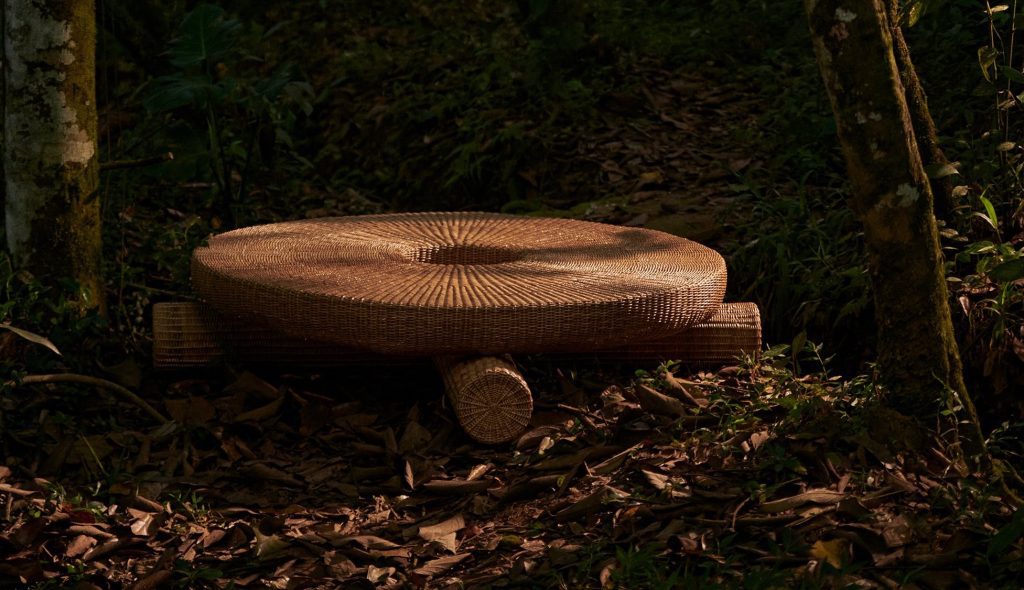

Here and There: A Palestinian Collection Introducing Palestinian Design on Adorno
“There is something about the work as a collection that I find really exciting. There is this invisible thread that connects the work together whether through similar influences, through the bold colors and sensual forms, or through a similar research-based methodology.”
– Dima Srouji, founder of design project Hollow Forms and curator of “Here and There”
View “Here and There: A Palestinian Collection”; all images courtesy the designers.
Adorno is excited to introduce the Palestinian design scene on our platform, visually illustrated through its inaugural collection “Here and There: A Palestinian Collection”. The collection has been curated by designer and architect Dima Srouji, who, with experience working in the state of Palestine and abroad, brings her interdisciplinary approach to design and curatorial commentary to the presentation of this scene. As a designer, Srouji explores issues of identity, globalisation, and tradition through her design project Hollow Forms.
“Here and There: A Palestinian Collection” gives audiences a view into the collaborative and diverse world of the contemporary Palestinian design scene. The scene has been characterised by a strong heritage of traditional craftsmanship and an artistic focus on technique, materials, and form. With the territory’s long and ongoing political uncertainty, the scene exists both in the state of Palestine and abroad in its many diasporic communities. From a curatorial perspective, Srouji describes that “this collaborative and diverse creative energy allows for intersections between local knowledge and global know-hows and has placed Palestinian design alongside global productions. Design is a collective denominator where each designer is revisiting a local industry with a new perspective whether in Palestine or abroad”. In this way, the Palestinian design scene can be seen to both maintain the use of traditional, local knowledges as well as incorporate contemporary techniques and materials, bringing together craftspeople and contemporary designers to illustrate the multitude of artistic Palestinian identities.
Despite the generational, geographical, and cultural divides, artists and designers, including those presented in the “Here and There” collection, are able to actively contribute to the continuity and development of contemporary Palestinian design, sharing their collective and individual artistic viewpoints with the larger world. This collection spans a variety of media, techniques, and forms and includes work from Hollow Forms, Local Industries, Moïo Studio, Faissal El-Malak, and Turabi Ceramics.
Interview with Dima Srouji, founder of design studio Hollow Forms and curator of “Here and There”
Which three words would you use to describe the contemporary Palestinian design scene?
Collaborative, storytelling, and bright – in more than one way.
In what ways has the scene been shaped or impacted by the political climate of Palestine?
We get this question all the time and the immediate answer we respond with is that it doesn’t. This is a wishful statement and, perhaps, somewhat in denial of the privilege those in the design scene have to be able to function on a global scale – but, it is also true to an extent. There are limits to who can participate in the global design scene considering travel bans and lack of local facilities as simple examples of how the political climate is affecting the design scene.
More importantly, I think many designers, including myself, feel an emotional attachment to place more than, perhaps, we would have if we were not under an apartheid regime. We carry a responsibility of resistance through anything that we do, whether it’s highlighting the history of a specific craft or furthering the discipline locally. It’s perhaps the way we feel about “home” or “belonging” that affects me the most. I won’t speak for the other designers here; I think everyone feels differently about how their identity and political life affects their design work.
Top: Turabi Ceramics, “MARBLED PALESTINE (LARGE SERVING BOWL)” // Bottom, L-R: “MARBLED PALESTINE (OVAL PLATTER)” & “MARBLED PALESTINE (18 CM BOWL)”
What aspect(s) of the Palestinian design scene are you most excited to share with Adorno’s audience?
There is something about the work as a collection that I find really exciting. There is this invisible thread that connects the work together whether through similar influences, through the bold colors and sensual forms, or through a similar research-based methodology. It’s the first time that a Palestinian design collection is shown together that I know of.
It’s a good time for us to also question what we want to develop together moving forward. There is a group of around ten of us that have started questioning what it means to identify as a Palestinian designer [and] if that’s even important in the first place. There’s also the question of whether we need to categorize or coalesce as a scene. It’s a good time to embrace complexity rather than clarity.
Local Industries, “Mike Rocking Chair“
How have you approached the curation of your first collection, “Here and There: A Palestinian Collection”?
I saw this as an opportunity to showcase Palestinian designers physically based in Palestine alongside Palestinian designers in the diaspora. There are a few people that are developing similar interests [or] techniques that may also not know each other. Connecting them together in this platform is a good start to what potentially [could] be a long-term collaboration process between the group of designers.
I selected designers that are both interested in a really high-end craft [and] also have very satisfying contemporary forms. This is seen in Maia Beyrouti‘s bright blue vessels, Local Industries‘ bold colors and exquisite details, and so on. Everyone is also rooted to a certain extent to a specific local industry. For example, glass, ceramics, metalworking, and textile have all been deeply rooted in the history of Palestinian craft for centuries. Seeing that integrated with contemporary design forms is really exciting.
Faissal El-Malak, “‘Bird’ Jug“
As a designer yourself, how has your background in architecture and design influenced your curatorial approach?
I’ve always been interested in both interdisciplinary and multidisciplinary approaches to my work. My projects always start with a deep research methodology, so for me, even my glassblowing project begins with research on the history of glassblowing in the Levant and even looks into the colonial history of archaeology in Palestine. Working with expert glassblowers that have developed their practice locally in the last three decades is humbling and working together in a genuine collaboration is something that I really find important, whether [I’m working] on an architectural project at the scale of a building or the scale of an object – I see the two processes the same.
In terms of curation, I find that the designers I chose to work with have a very similar approach. They all struggle with identifying as only designers. Local Industries are primarily architects running AAU Anastas; Faissal El Malak, a fashion designer by training and practice; Inas Halabi, a brilliant researcher and artist; Maia Beyrouti also developed multiple projects beyond the design sphere. I feel that bringing them all together under a design umbrella says a lot about how complex and rich contemporary design is.
Hollow Forms, “Alienation 1“
In which way(s) do these designers and their practices represent the contemporary Palestinian design scene?
They possibly most accurately represent the contemporary Palestinian design scene – considering their privileged access to the global scene. There are many designers I may not know given my limited access to Gaza, for example.
It also depends on what we mean by design here. There is a blurred line between craft and design these days that I think about very often. It’s important to entertain the complexity of the design scene here. Could the craftsmen themselves take part in this collection, for example? Maybe something I didn’t add into this collection is all the designers in Gaza and the West Bank that attempt to solve problems caused by the occupation through design interventions. For example, a woman using construction rubble to make structural bricks. But, in the context that I’m presenting it, which is a very specific one, it’s also an exciting time. The scene is very small and very young – the new college of Design at Birzeit University is [just] two years old. I think that the next ten years are going to be really exciting to watch in Palestine as designers connect around the world and as students start to graduate with a design degree from Birzeit for the first time. I’m really looking forward to the next decade of design from Palestine.


Moïo Studio, “Stoneware Vessel ‘L-022’, Stoneware Vessel ‘T-428’, & Stoneware Vessel ‘L-023’ from the Modern Ancestors Collection”
“Here and There: A Palestinian Collection” is available on Adorno from 25 April 2020. An exclusive interview with curator Dima Srouji will be streamed live on Adorno’s instagram, @adorno.design, on 25 April at 19.00 CEST























Responses